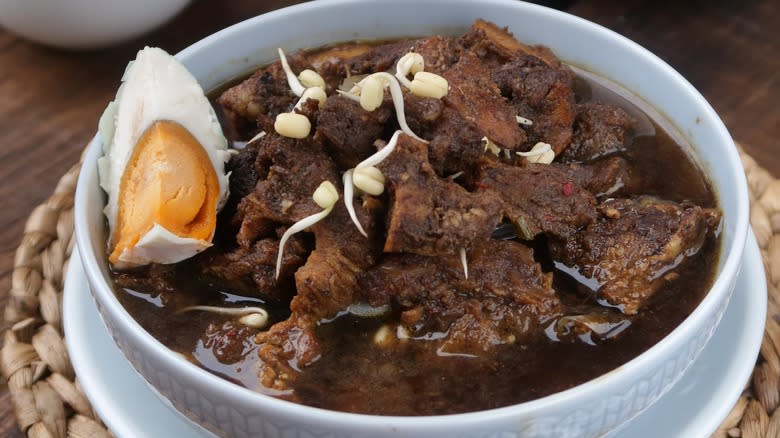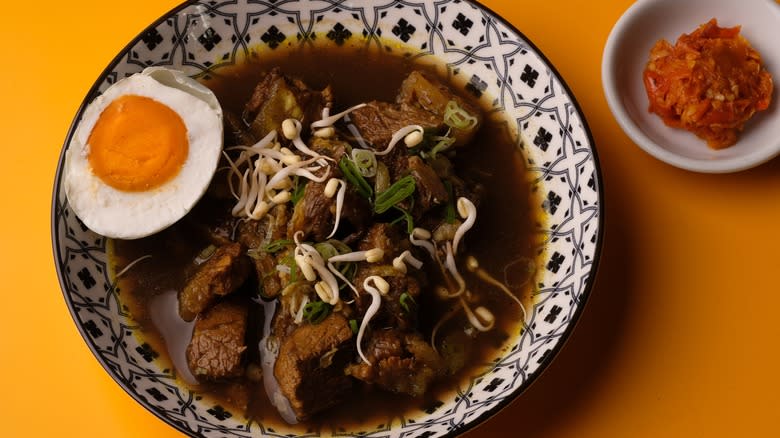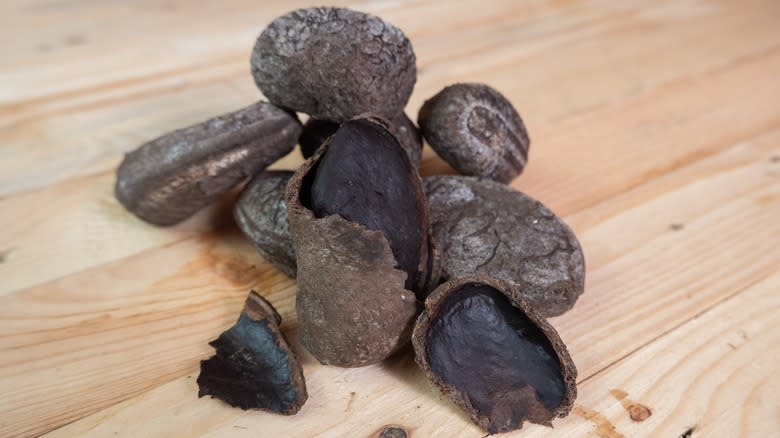Rawon Is The Indonesian Beef Soup That Requires A Nutty Special Ingredient

Indonesia -- the world's largest archipelago -- is astounding: Over 275 million people living on more than 6,000 inhabited islands. Underlaid by rich volcanic soil, tropical climates, a broad array of biodiversity, and centuries of trade, it's no surprise the Asian nation features a dizzying array of tasty foods.
For a delicious foray into the flavorful world of Indonesian cuisine, seek out rawon, a dish born out of East Java. A beef soup made with a bouquet of aromatics, its star ingredient is a nut called kuelak. Such an ingredient lends the dish a dark, nearly pitch-black color, and the taste is just as impressive as the color: slightly bitter, acidic, earthy, and full of spice. When matched with the tender, slow-cooked morsels of beef, the dish brims decadent bites. Plus, to break up the soup's rich flavor, rawon's accompanied by side snacks like salted duck eggs, crackers, and bean sprouts.
Read more: 20 Popular Canned Soups, Ranked Worst To Best
Background Of Rawon

The rich soup hails from Surabaya, a large city in eastern Java, Indonesia. As a prominent trading hub for centuries, it's no surprise the dish incorporates an aromatic array of spices. Rawon's preparation has long been interlinked with the region, first noted in a religious inscription from the 10th century. Nowadays, it's a staple across Java, found ubiquitously at street stalls throughout the island. And its popularity has spread abroad, too -- it's enjoyed in Bali, Singapore, and Malaysia.
Alongside keluak, the soup is defined by its beef shank broth. Atop such a meat base, the soup is built using frequently utilized Indonesian aromatics like galangal, lemongrass, ginger, turmeric, and shallots, as well as candlenuts, cumin, coriander, tamarind, and a further range of shifting components. However, such a remarkably tasty dish all boils down to the unique nut that lends rawon its characteristic flavor. The manner in which aromatics meld with keluak creates such a distinct dish.
Keluak Lends Rawon Its Characteristic Flavor

Keluak -- called by varying names like pangi, puchong, and kluwak -- is a nut that emerges from the Pangium tree. Native to the mangrove swamps of Indonesia, it contains poisonous hydrogen cyanide, which necessitates a complex processing method of washing, fermenting, and boiling to eliminate. Such labor-intensive handling renders it a relatively rarely employed ingredient. However, its flavor is worthwhile -- hence its esteem in Indonesian and Peranakan cooking. The nuts bring a hefty dose of umami, with olive and mushroom-like savoriness, accompanied by wood-like undertones and even a bit of smokiness.
Keluak's flavor delectably melds with rawon's bright aromatics and floral array of spices. The nut's flesh is typically pounded in a mortar and pestle during preparation, which aids in blending its taste into the dish. A pan-top toasting blooms its flavors, and the subsequent simmering further concentrates the taste. The result is a savory, rich liquid full of flavor.
Read the original article on Tasting Table.